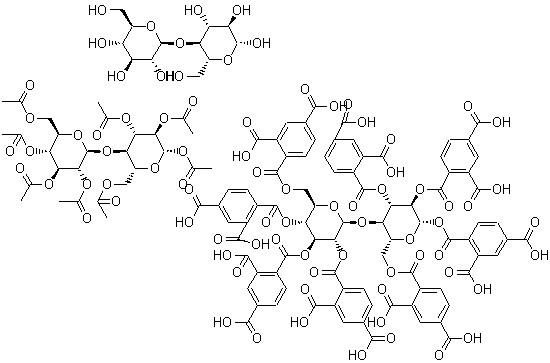-
Name
CELLULOSE ACETATE
- EINECS
- CAS No. 9004-35-7
- Density 1.3g/mLat25°C(lit.)
-
Solubility
Stability
- Stable. Combustible. Incompatible with strong oxidizing agents.
Toxicology
- May act as a respiratory or eye irritant. Typical TLV/TWA 10 mg/m3.
- Melting Point 230-300℃
- Formula [C6H7O2(OH)3-m(OOCCH3)m],m=0~3
- Boiling Point 210 °C
- Molecular Weight 0
- Flash Point 304 C (closed cup)
- Transport Information
- Appearance white powder
-
Safety
WGK Germany -
- Risk Codes
-
Molecular Structure
- Hazard Symbols
- Synonyms a432-130b;acetatecotton;acetateesterofcellulose;aceticacid,celluloseester;acetose;acetyl35;allogel;ampacetc/a
- PSA 63.22000
- LogP -0.09540
Toxicity data
Cellulose acetate Chemical Properties
density: 1.3 g/mL at 25 °C
refractive index: n20/D 1.475
Other names: cellulose acetate sac 20; cellulose acetate dac 20; Cellulose Mono Acetate; Cellulose Monoacetate;
Cellulose acetate(9004-35-7) is the acetate ester of cellulose.
Cellulose acetate(9004-35-7) is moldable, in contrast to cellulose nitrate, which is not. It, however, has poor resistance to moisture. To overcome this disadvantage, treating the cotton linters with a mixture of butyric acid, acetic acid, and acetic anhydride produces a mixed acetate-butyrate.
The Structure of Cellulose acetate(9004-35-7):

Cellulose acetate History
Cellulose acetate Uses
Cellulose acetate(9004-35-7) is used as a film base in photography, and as a component in some adhesives.
Cellulose acetate(9004-35-7) is also used as a synthetic fiber.
Cellulose acetate Production
There are several production methods for Cellulose acetate(9004-35-7):
1. Purified cellulose from wood pulp or cotton linters
2. Mixed with glacial acetic acid, acetic anhydride, and a catalyst
3. Aged 20 hours- partial hydrolysis occurs
4. Precipitated as acid-resin flakes
5. Flakes dissolved in acetone
6. Solution is filtered
7. Spinning solution extruded in column of warm air. Solvent recovered
8. Filaments are stretched and wound onto beams, cones, or bobbins ready for use
Cellulose acetate Safety Profile
Related Products
- Cellulose
- Cellulose acetate
- Cellulose acetate phthalate
- Cellulose diacetate
- CELLULOSE GLYCOLIC ACID SODIUM SALT
- Cellulose microcrystalline
- Cellulose,ethers,carboxymethyl ether,calcium salt
- 9004-36-8
- 9004-38-0
- 9004-41-5
- 90045-23-1
- 90045-28-6
- 90045-36-6
- 90045-38-8
- 9004-53-9
- 9004-54-0
- 90045-43-5
Hot Products
About|Contact|Cas|Product Name|Molecular|Country|Encyclopedia
Message|New Cas|MSDS|Service|Advertisement|CAS DataBase|Article Data|Manufacturers | Chemical Catalog
©2008 LookChem.com,License: ICP
NO.:Zhejiang16009103
complaints:service@lookchem.com Desktop View